25 Sep Keratoconus
What is Keratoconus?
Normal cornea, the first transparent coat of the eye, is a dome shaped coat or layer with sphero-cylindrical shape like a football. When this layer tends to protrude and bulge forward with thinning, it tends to assume the shape of a cone or a baseball, this is called keratoconus.
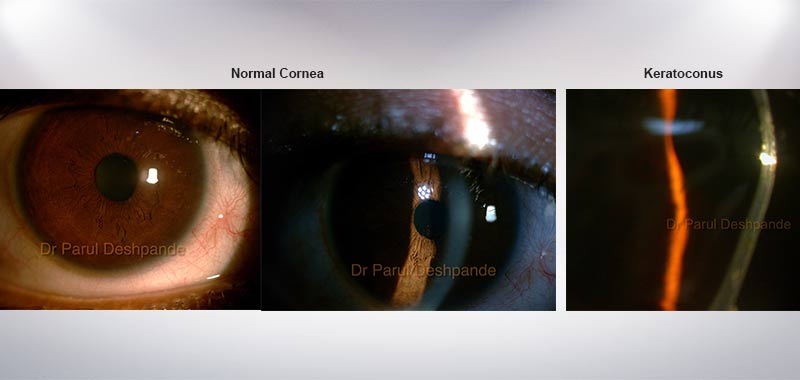

What are the reasons for developing keratoconus?
There are no very known reasons for developing keratoconus but in some, it has been associated with long term rubbing of eyes, allergic eye conditions and in some found to be familial, running in families through few generations.
What are the symptoms of Keratoconus?
- Any rapidly changing glass prescription esp. cylinders
- Double vision with one eye
- Glare and haloes in the night
- Blur, glare and distortion of images
- Decrease in the vision for all distances, esp. With artificial lights around like in the night.
How to diagnose Keratoconus?
It usually occurs in the age group of 10-25 years initially progressing rapidly, then slowly for few years before becoming stable. Rarely onset is delayed in 20’s with slow progression.
It usually affects both the eyes but starts in one eye first followed by the second eye. Eventually both the eyes get affected.
It is very important to consult an eye doctor if a child in age of 10 to 25yrs has constant changing spectacle power especially cylindrical power. Corneal Topography, which maps of the shape of cornea, can pick up this condition in the eyes in very early stages. Many times it is picked up when someone undergoes this test prior to undergoing LASIK procedure.
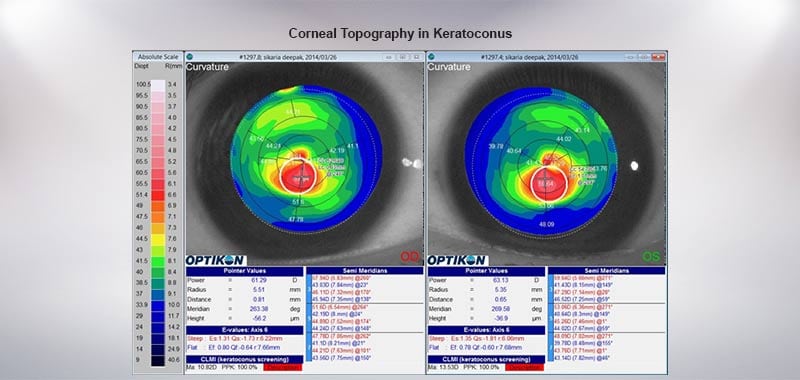

Moderately developed cases will show typical bowing forwards with protrusion and thinning of the central part of the cornea, which can be picked up in routine eye examination. One needs to be a cornea specialist dealing with these cases regularly, to pick it up in very early condition.
In some cases, the disease may be very aggressive and fast resulting into severe thinning of cornea, where inner layers of the cornea split up causing water accumulation into the cornea called as Hydrops, making the whole cornea cloudy or white.
A complete evaluation of the eyes, especially cornea, should be done by a cornea specialist, in the children with progressive increase in cylinder or sometimes sphere in spectacle prescription.
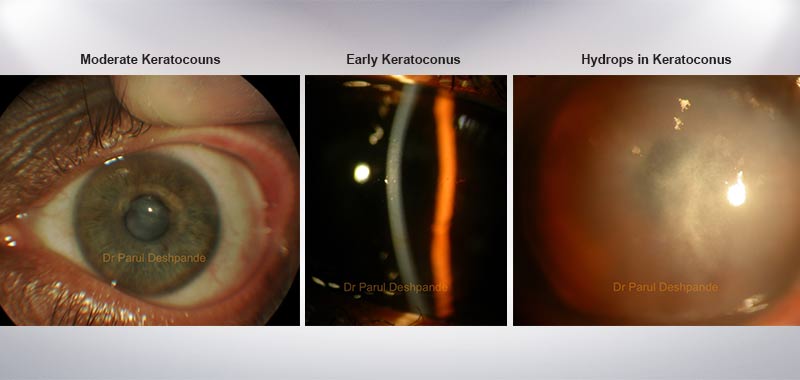

What is the treatment of keratoconus?
Treatment of keratoconus basically involves correction of two important issues, i.e. vision correction and stabilization of the progressive nature of corneal thinning in keratoconic eyes.There are two main important aspects to mange when it comes to keratoconus.
First step of treatment is to stop progression of the condition so that disease is stabilized and cornea doesn’t become severely deformed or develop hydrops.
Second to improve vision by means of either Glasses, Specialized contact lenses or Surgeries like Intacs, DALK or Penetrating Keratoplasty.
Corneal Collagen cross-linking therapy is an innovative breakthrough treatment to halt progression of keratoconus and corneal ectasia. It is available at our centre since 2007.
Use of Selective lasers, Intacs (Intrastomal Corneal Rings) and Implantable Collamer Lens (ICL) in addition to cross-linking has made spectacle free vision possible for these eyes.
Glasses help to improve vision only in early stages but specialized contact lenses like Rose K2 lens, piggyback lenses, Kerasoft or miniscleral and Boston Scleral lenses help providing a useful non distorted vision in fully developed cases.
Intacs or Intracorneal Ring Segments are specialized treatments, aimed to modify the deformed shape in Keratoconus. They are placed within the layers of cornea by means of Femtosecond laser (Bladeless), which flatten the steep cornea and help in improving the uncorrected (Glass or Contact lens free vision) vision of Keratoconic eyes.
Corneal Intrastromal rings (ICRS)
ICRS are PMMA ring segments which are inserted in the cornea in its midperiphery in order to alter the shape of the cornea in keratoconus.
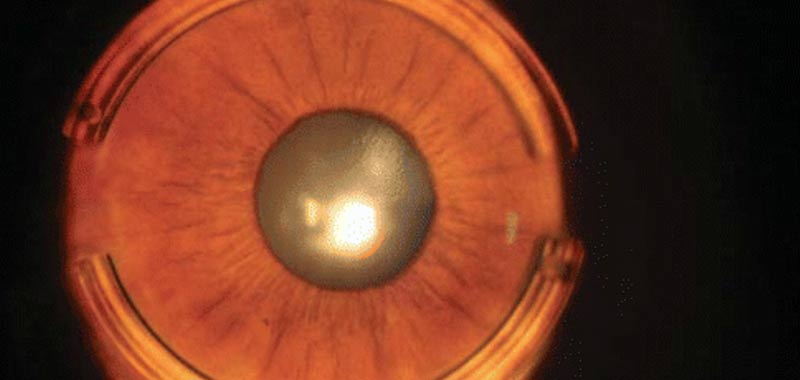

ICRS helps control the irregular astigmatism to more regular astigmatism, which can be treated with conventional methods, such as spectacles or contact lenses or ICLs. The need to use glasses or implantation of Phakic intraocular lens (ICL) still remains essential to get a clear, relatively undistorted vision after ICRS.
The intracorneal ring segments do not treat or eliminate the existing disease, but work as an alternative to decrease the astigmatism and corneal abnormality and thus improve the vision to acceptable limits, aiming to at least delay, if not eliminate, the need of corneal grafting.
The intracorneal ring acts as tissue addition leading to a flattening in the cornea periphery, which results in a reduction of astigmatism and improved visual acuity.
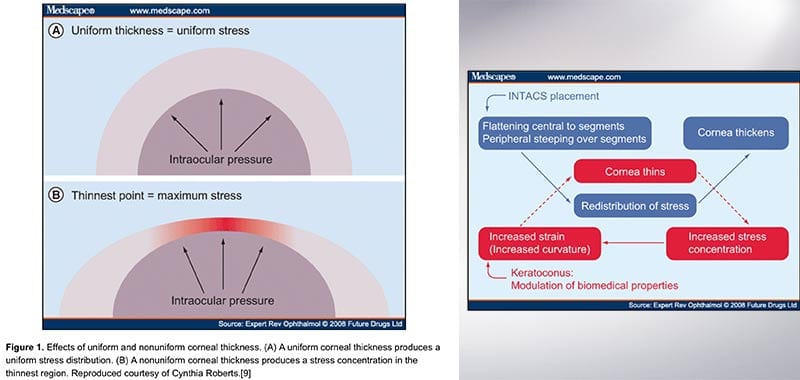

Ring segments can be inserted into the cornea by creating a channel by a manual technique or by use of Femtosecond laser. It takes only few minutes (15-20mins) to insert rings and is done under drop anesthesia (No injection).
Reversibility
ICRS can be explanted and removed, in some unforeseen circumstances, with complete reversal of the cornea to its pre-insertion level. They do not alter the success of any later procedure like Deep Anterior Lamellar Keratoplasty.
ICL or Phakic IOL implantation
This is done in cases of stable, nonprogressive stages of Keratoconus, most commonly 6-12 months after CXL treatment. It corrects the cylindrical as well as spherical power of the eye to improve the unaided vision. It is most suitable for corneas with central early to moderate cone.In advanced stages it needs to be coupled with Intacs or DALK to improve the unaided vision. The suitability of the eye for Phakic IOL can be guided to you the best by your eye doctor, after complete evaluation of the cornea by topography or tomography.
Corneal Transplant procedures like Deep anterior lamellar keratoplasty (DALK) or Full Thickness Keratoplasty is a choice of procedure in advanced stage of keratoconus where lenses do not provide either a clear vision or fit improperly or in cases of hydrous or dense scars at the apex of keratoconic cornea.
We, at SEE, provide all the facilities to treat these keratinous eyes.


2,485 Comments